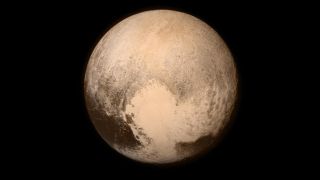Hello ladies and gents this is the Viking telling you that today we are talking about
Dwarf planet Pluto: Facts about the icy former planet
Pluto was once considered the ninth planet, before being demoted in 2006.
A wide view of Pluto taken by the New Horizons space probe in July 2015. (Image credit: NASA/Johns Hopkins University Applied Physics Laboratory/Southwest Research Institute)
Pluto, once considered the ninth and most distant planet from the sun, is now the largest known dwarf planet in the solar system. It is also one of the largest known members of the Kuiper Belt, a shadowy zone beyond the orbit of Neptune thought to be populated by hundreds of thousands of rocky, icy bodies each larger than 62 miles (100 kilometers) across, along with 1 trillion or more comets.
In 2006, Pluto was reclassified as a dwarf planet, a change widely thought of as a demotion. The question of Pluto's planet status has attracted controversy and stirred debate in the scientific community, and among the general public, since then. In 2017, a science group (including members of the New Horizon mission) proposed a new definition of planethood based on "round objects in space smaller than stars," which would make the number of planets in our solar system expand from 8 to roughly 100.
American astronomer Percival Lowell first caught hints of Pluto's existence in 1905 from odd deviations he observed in the orbits of Neptune and Uranus, suggesting that another world's gravity was tugging at these two planets from beyond. Lowell predicted the mystery planet's location in 1915, but died without finding it. Pluto was finally discovered in 1930 by Clyde Tombaugh at the Lowell Observatory, based on predictions by Lowell and other astronomers.
Pluto got its name from 11-year-old Venetia Burney of Oxford, England, who suggested to her grandfather that the new world get its name from the Roman god of the underworld. Her grandfather then passed the name on to Lowell Observatory. The name also honors Percival Lowell, whose initials are the first two letters of Pluto.
WHAT DOES PLUTO LOOK LIKE?
Since Pluto is so far from Earth, little was known about the dwarf planet's size or surface conditions until 2015, when NASA's New Horizons space probe made a close flyby of Pluto. New Horizons showed that Pluto has a diameter of 1,473 miles (2,370 km), less than one-fifth the diameter of Earth, and only about two-thirds as wide as Earth's moon.
Observations of Pluto's surface by the New Horizons spacecraft revealed a variety of surface features, including mountains that reach as high as 11,000 feet (3,500 meters), comparable to the Rocky Mountains on Earth. While methane and nitrogen ice cover much of the surface of Pluto, these materials are not strong enough to support such enormous peaks, so scientists suspect that the mountains are formed on a bedrock of water ice.
And as always have a chilled day from the Viking

Comments
Post a Comment